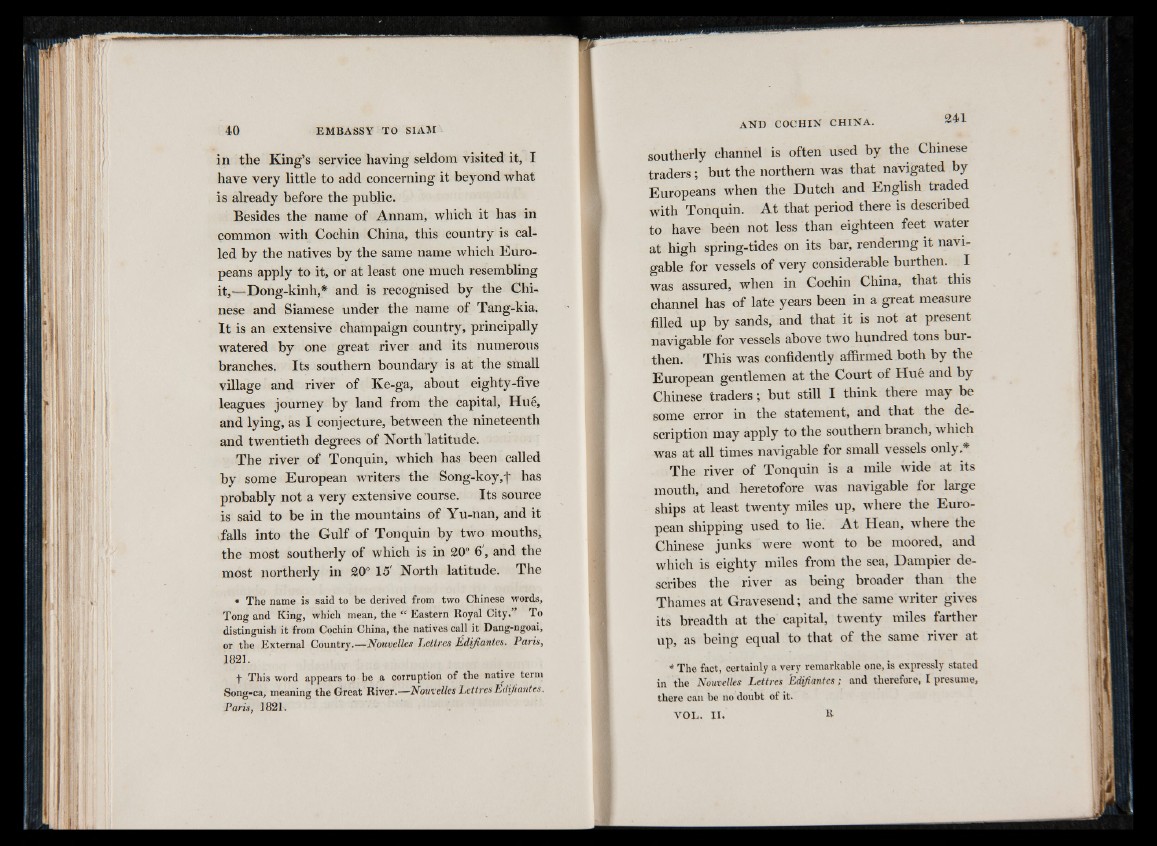
in the King’s service having seldom visited it, I
have very little to add concerning it beyond what
is already before the public.
Besides the name of Annam, which it has in
common with Cochin China, this country is called
by the natives by the same name which Europeans
apply to it, or at least one much resembling
it,—Dong-kinh,* and is recognised by the Chinese
and Siamese under the name of Tang-kia.
I t is an extensive champaign country, principally
watered by one great river and its numerous
branches. Its southern boundary is at the small
village and river of Ke-ga, about eighty-five
leagues journey by land from the capital, Hué,
and lying, as I conjecture, between the nineteenth
and twentieth degrees of North latitude.
The river of Tonquin, which has been called
by some European writers the Song-koy,f has
probably not a very extensive course. Its source
is said to be in the mountains of Yu-nan, and it
falls into the Gulf of Tonquin by two mouths,
the most southerly of which is in 20° 6', and the
most northerly in 20° 15' North latitude. The
• The name is said to be derived from two Chinese words,
Tong and King, which mean, the “ Eastern Royal City.” To
distinguish it from Cochin China, the natives call it Dang-ngoai,
or the External Country.—Nouvelles Lettres Édifiantes, Paris,
1821.
f This word appears to be a corruption of the native term
Song-ca, meaning the Great River.—Nouvelles L e t tr e s Edifiantes.
Paris, 1821.
southerly channel is often used by the Chinese
traders ; but the northern was that navigated by
Europeans when the Dutch and English traded
with Tonquin. A t that period there is described
to have been not less than eighteen feet water
at high spring-tides on its bar, rendering it navigable
for vessels of very considerable burthen. I
was assured, when in Cochin China, that this
channel has of late years been in a great measure
filled up by sands, and that it is not at present
navigable for vessels above two hundred tons burthen.
This was confidently affirmed both by the
European gentlemen at the Court of Hué and by
Chinese traders ; but still I think there may be
some error in the statement, and that the description
may apply to the southern branch, which
was at all times navigable for small vessels only.*
The river of Tonquin is a mile wide at its
mouth, and heretofore was navigable for large
ships at least twenty miles up, where the European
shipping used to lie. A t Hean, where the
Chinese junks were wont to be moored, and
which is eighty miles from the sea, Dampier describes
the river as being broader than the
Thames at Gravesend; and the same writer gives
its breadth at the capital, twenty miles farther
up, as being equal to that of the same river at
* The fact, certainly a very remarkable one, is expressly stated
in the Nouvelles Lettres 'Édifiantes ; and therefore, I presume,
there can be no doubt of it.
VOL. II. B